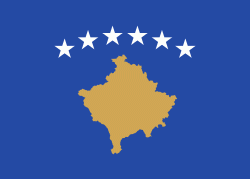Zvečan
Zvečan (Звечан) or Zveçan (Zveçani) is a town and municipality located in the Mitrovica District in Kosovo. As of 2015, it has a population of 16,650 inhabitants. It covers an area of 122 km2, and consists of a town and 35 villages.
Zvečan is a part of North Kosovo, a region with an ethnic Serb majority. According to the 2013 Brussels Agreement, the municipality should become a part of the Community of Serb Municipalities once they are established.
The town of Zvečan is located near Mitrovica. It was mentioned for the first time in connection with the border clashes between the Serbs and Byzantines between 1091 and 1094. There is also an inscription that Grand Prince Stefan Nemanja, after the victory over the Byzantines in 1170, ordered that a prayer for the successful outcome of the battle be held in the church of St George at Zvečan.
In the 13th and 14th centuries Zvečan was one of the royal residences of the Serbian court. Queen Theodora died there in December 1322, and nine years later her husband, Stefan Uroš III was imprisoned and strangled there.
First, the Musić, then the Vojinović noble family, held the fortified city and region during the Serbian Empire of Uroš V (r. 1355–1371). As imperial power collapsed Zvečan was in a disputed zone being held by nobleman Miloš Pović in 1370 but claimed by Nikola Altomanović.
In 1389, after the Battle of Kosovo, it was integrated into the Ottoman Empire and later became part of the Sanjak of Novi Pazar.
From 1878 to 1908 it, along with the rest of the Sanjak, was administered by the Austro-Hungarian Empire as a result of the Congress of Berlin. But in 1908 it was returned to Turkey.
On the highest spot, i.e., the Upper Town, there are remains of St George's church, cistern and the main octagonal tower. The ramparts of this part of the fort are reinforced by massive towers. The main entrance to the town was on the western side.
Zvečan is a part of North Kosovo, a region with an ethnic Serb majority. According to the 2013 Brussels Agreement, the municipality should become a part of the Community of Serb Municipalities once they are established.
The town of Zvečan is located near Mitrovica. It was mentioned for the first time in connection with the border clashes between the Serbs and Byzantines between 1091 and 1094. There is also an inscription that Grand Prince Stefan Nemanja, after the victory over the Byzantines in 1170, ordered that a prayer for the successful outcome of the battle be held in the church of St George at Zvečan.
In the 13th and 14th centuries Zvečan was one of the royal residences of the Serbian court. Queen Theodora died there in December 1322, and nine years later her husband, Stefan Uroš III was imprisoned and strangled there.
First, the Musić, then the Vojinović noble family, held the fortified city and region during the Serbian Empire of Uroš V (r. 1355–1371). As imperial power collapsed Zvečan was in a disputed zone being held by nobleman Miloš Pović in 1370 but claimed by Nikola Altomanović.
In 1389, after the Battle of Kosovo, it was integrated into the Ottoman Empire and later became part of the Sanjak of Novi Pazar.
From 1878 to 1908 it, along with the rest of the Sanjak, was administered by the Austro-Hungarian Empire as a result of the Congress of Berlin. But in 1908 it was returned to Turkey.
On the highest spot, i.e., the Upper Town, there are remains of St George's church, cistern and the main octagonal tower. The ramparts of this part of the fort are reinforced by massive towers. The main entrance to the town was on the western side.
Map - Zvečan
Map
Country - Kosovo
 |
 |
In classical antiquity, the central tribe which emerged in the territory of Kosovo were the Dardani, who formed an independent polity known as the Kingdom of Dardania in the 4th century BC. It was annexed by the Roman Empire by the 1st century BC, and for the next millennium, the territory remained part of the Byzantine Empire, whose rule was eroded by Slavic invasions beginning in the 6th–7th century AD. In the centuries thereafter, control of the area alternated between the Byzantines and the First Bulgarian Empire. By the 13th century, Kosovo became the core of the Serbian medieval state, and has also been the seat of the Serbian Orthodox Church from the 14th century, when its status was upgraded to a patriarchate. Ottoman expansion in the Balkans in the late 14th and 15th century led to the decline and fall of the Serbian Empire; the Battle of Kosovo of 1389 is considered to be one of the defining moments in Serbian medieval history. The Ottomans fully conquered the region after the Second Battle of Kosovo. The Ottoman Empire ruled the area for almost five centuries until 1912.
Currency / Language
| ISO | Language |
|---|---|
| SQ | Albanian language |
| SR | Serbian language |















